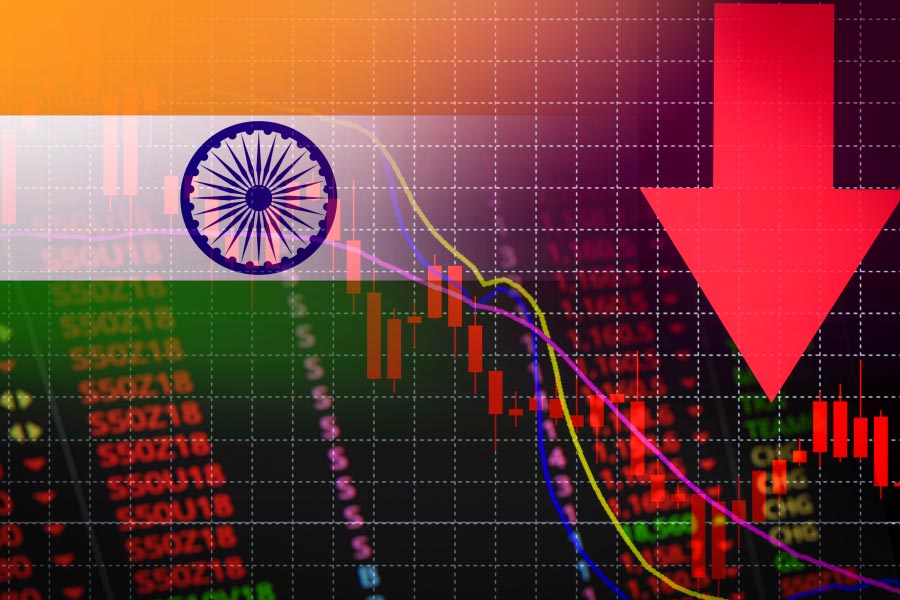Signs of a slowing US economy sowed panic among investors on Monday, with a sell-off in markets that began last week turning into a global rout.
Bourses from Asia to Europe took a beating with Japanese shares at one point exceeding their 1987 “Black Monday” loss and bond yields slipped as investors rushed to safe-haven assets and bet the US Federal Reserve would now need to cut interest rates aggressively to spur growth. The Nikkei closed 12.40 per cent lower at 31458.42, its largest one-day fall since October 1987.
The declines followed a US jobs report on Friday that showed significantly slower hiring, with unemployment rising to its highest level in nearly three years. This deepened fears that the world’s largest economy could be sliding into a recession and that the Federal Reserve may have waited too long on cutting interest rates.
In trading on Monday, the S&P 500 dropped by 2.70 per cent and the tech-heavy Nasdaq plunged by nearly 4 per cent. The Dow Jones was down 2.51 per cent.
The tremors in the market were accentuated by the surge in the yen against the dollar after the BoJ raised rates for the second time this year, which knocked the bottom out of the yen carry trades that have significantly propped US bourses.
The bourses have also been gripped by fears over the developments in the Gulf region after recent Israeli attacks killed top Hamas officials, prompting Iran to threaten deadly reprisals.
Domestic equities also got sucked into the sell-off. The rout wiped out more than ₹15 trillion of investor wealth and saw the Sensex bleeding 2222.55 points, while the broader Nifty tanked 662.10 points.
Economists are now blaming the US Federal Reserve for the stock rout as the central bank has been behind the curve in cutting interest rates to stimulate growth.
The market crash and fears of recession have raised expectations of a rate cut by the Fed — possibly by holding a out of turn meeting that may happen over the next few days.
The second reason behind the bloodbath owed its origins to Japan. Recently, the Bank of Japan (BoJ) raised its key interest rate to 0.25 per cent from its previous range of zero to 0.1 per cent that led to an appreciation in the Yen, which badly hit the carry trade.
This is a trading strategy in which an investor borrows from a country which has ultra-low interest rates and uses the proceeds to buy riskier assets such as shares overseas.
This works if the home currency — from which the money is borrowed — depreciates and the interest rates stay low. The reverse happened in Japan that resulted in investors selling their holdings
However, in Japan both of these did not happen. It resulted in such investors selling their holdings.
The investors also had to cough up more yen to repay their loans, and the fresh demand led to another round of appreciation in the value of the yen.
“The recent hike in Japanese interest rates and appreciation in the yen has led to a double whammy for yen carry traders who have to pay back in yen and suffer losses on their investments too,’’ Apurva Sheth, head of market perspectives and research, Samco Securities said.
The Sensex tanked 2222.55 points or 2.74 per cent to end at over a month’s low of 78759.40, marking its worst single-day fall since June 4, 2024. During intra-day trades, the gauge plummeted 2686.09 points or 3.31 per cent to 78295.86.
On the NSE, the Nifty slumped 662.10 points or 2.68 per cent to finish at more than a month’s low of 24055.60. During the day, it crashed 824 points to 23893.70.
In the broader market, the BSE smallcap gauge dropped 4.21 per cent and midcap index plummeted 3.60 per cent.
“The global market is reeling as bears enter with a cocktail of bad news. The fear of a reverse Yen carry trade, following an interest rate hike in Japan, was the initial catalyst. This was compounded by fears of a recession in the US after extremely poor jobs data, which spooked market sentiment,” said Santosh Meena, head of research, Swastika Investmart Ltd, said.
Experts, however, said the fall in Indian equities may not be to the extent seen in other markets because of strong participation from domestic institutional investors.
This was evident on Monday with provisional data showing that while foreign portfolio investors (FPIs) sold stocks worth ₹10,074 crore, domestic institutions were net buyers of ₹9,156 crore.
One of the question being asked is the participation of Japan-based FPIs in the domestic markets. According to NSDL data, the total assets under custody (AUC) of these investors cumulatively stand at ₹2.29 lakh crore of which ₹2.17 lakh crore is into equities. The rest is held in debt, debt/VRR (voluntary retention route) and hybrid instruments.
The crash in the stock markets had its impact on the rupee which ended at a record low of 83.85 to the dollar against its previous close of 83.73 to the greenback.
At the inter-bank forex market, the domestic unit opened weaker at 83.78 on strong demand for the US currency amid FPI outflows. Forex circles said that intervention from the Reserve Bank of India (RBI) prevented a big fall in the domestic unit.
“We expect the rupee to trade with a negative bias on risk aversion in the global markets. Escalation of geopolitical tensions in West Asia and outflows by foreign investors may further pressurise the domestic unit,” Anuj Choudhary – research analyst at Sharekhan by BNP Paribas said.
With inputs from NYTNS & Reuters











